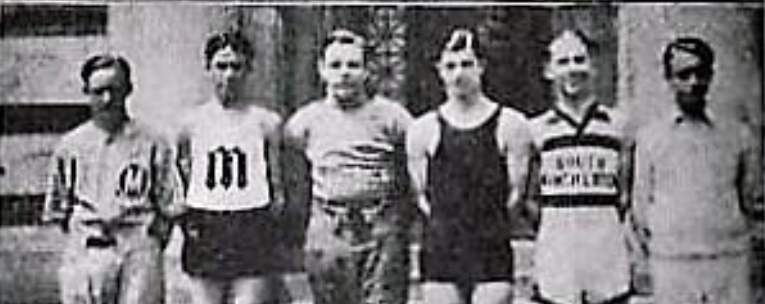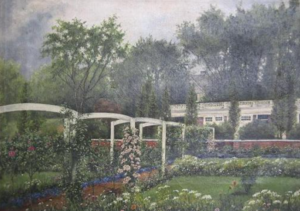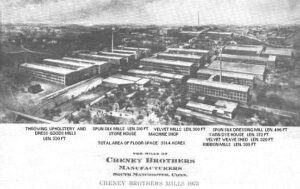By Rick Dyer, archivist of the Manchester Road Race Committee

Spoken at a reception celebrating Joe on Friday, May 19, 2017 Twelve-year-old Joe McCluskey bounds out the front door and onto the porch at 40 Foster Street. There’s a canvass newspaper bag slung over his shoulder. Joe is tall and stick-figure thin. He has a shock of wavy black hair. His long legs are skinny, but his calves are as hard as coiled steel. He’s a kid with drive, ambition, and a powerful work ethic. He inherited all these traits from his Irish immigrant parents, who came to Manchester because they heard the Cheney Mills were hiring.
Young Joe shoves a stack of Hartford Courant newspapers into his sack. Then he starts to run. He races down Foster Street, flipping the papers onto the doorsteps and stoops of the houses along his route. The kid never breaks stride. Every so often, he hurdles a shrub, or leaps over a picket fence, to save time as he completes his deliveries before school.
That thin, determined paperboy never stopped running. He was the state mile champion at Manchester High School. He became a 13-time All-American runner at Fordham University. The New York City sportswriters nicknamed him the “Fordham Flash” and “Shufflin’ Joe.” They called him Shufflin’ Joe because of his unusual locked-kneed running gait, and the way his arms swung from side to side as he ran.

Joe McCluskey’s experiences vaulting over shrubbery and fences as a paperboy served him well at Fordham, where he began running the steeplechase race. The steeplechase is a grueling 3000-meter-long event that is run on a track, but has some of the elements of a cross country run. The competitors are required to clear four wooden hurdles and leap over a water pit during each of the seven laps they run around the track. It is a tough, gritty race. To be good at it, an athlete needs the speed of a miler, the endurance of a marathon runner and the skill sets of a hurdler and long jumper. And Shufflin’ Joe McCluskey was very, very good at the steeplechase.

award ceremony.
He set the world record for the event in 1932, while he was a junior at Fordham. Later that summer, at the age of 21, McCluskey won the Olympic bronze medal in the steeplechase at the 1932 Los Angeles Olympic Games. He should have received the silver medal. An Olympic official miscounted the number of laps that the field had competed. Joe was in second place at the end of the regulation distance. But he was passed at the very end of the extra eighth lap by Tom Evenson, a British Olympian.
A protest was lodged. The Olympic officials offered to untangle the placement controversy by having the two men compete in a run-off race the following day. In a true gesture of sportsmanship, Joe McCluskey conceded the silver medal to the British runner. “A race has only one finish line,” he said. There is a wonderful photograph of Joe standing on the Olympic podium that day during the medal ceremony. There is no disappointment on his face, just a beaming smile.
Manchester honored its hometown Olympic hero with a parade on Main Street when he got back from Los Angeles. Then Joe returned to Fordham, where he continued to win marquee races and national titles, and earned a degree in accounting.
McCluskey won the Manchester Road Race four times – in 1930, 1931, 1932, and 1947. He was 19 years old when he won it the first time, and 36 years old when he recorded his last first-place Turkey Day finish here. He was primarily responsible for the Rick Dyer, speaking at the Manchester History Center, Manchester, Connecticut, May 19, 2017. Joe, second from left, captain of the South Manchester High School (SMHS) track team, 1928-29. 1932 Olympic award ceremony. huge public interest in the Thanksgiving Day road race early on, and for its resurgence after World War II. There is a great story behind his 1947 victory.

Joe served four and a half years on active duty as a Naval Officer during the War. He spent some of his tour at the submarine base in Groton, where a sailor named Yogi Berra worked for him in the base’s morale, welfare, and recreation division. But from 1944 until 1946, Lieutenant McCluskey was at sea, serving aboard a small troop attack ship named the USS Bracken. The Bracken was only 426 feet long. Think about that for a moment. The Olympic medalist who was accustomed to winning long-distance races spent two years afloat in the South Pacific on a ship that measured 130 meters in length.
When Joe was discharged in 1946, he returned to Manchester and ran in the Road Race that Thanksgiving. The event had just resumed the year before after a 10- year hiatus. Joe placed third behind Charlie Robbins and Tommy Crane in 1946. It was a great showing by a war veteran who hadn’t been able to train much during two years of sea service. But the fiercely competitive McCluskey was very disappointed. He especially hated to lose before a hometown crowd.
Robbins, a Manchester native who was also a world-class runner, said that Joe “was loaded for bear” when he showed up at the Manchester Road Race in 1947. McCluskey, at age 36, won the road race with a gutsy, blistering finishing kick down Main Street. He is still the oldest athlete to win a Thanksgiving Day championship here. “I’ve never had a greater thrill in my entire career than winning today,” Joe told Manchester Herald Sports Editor Earl Yost. That quote came from an Olympian who won 27 national track titles, the most ever by any runner in the United States.
Joe McCluskey competed in the 1932 and 1936 Olympic Games. He was selected to represent the United States at the 1940 Olympics, which were canceled due to World War II. And in 1948, when he was 37 years old, he missed qualifying for an Olympic berth in the steeplechase by just two yards. A magazine printed a picture of Joe lying on the ground totally exhausted after that qualifying race. Many years later he would tell a reporter: “When you can’t stand at the end of a race, you know you’ve given everything.” “I ran a lot of races when I couldn’t stand at the end.”
After the war, Joe worked in New York City as a stockbroker. At age 42, he married Anne Conger, the daughter of U.S. District Court Judge Edward A. Conger. Joe and Anne raised eight children.
McCluskey coached the New York Athletic Club Track & Field team for many years, and was inducted into the National Track and Field Hall of Fame. He continued to compete in track and field events as a master well into his 80s.
When Joe McCluskey died in 2002 at the age of 91, his obituary in The New York Times noted that at age 73, he once ran 12 events in 13 hours. It told how he had taken up the shot put, and built a pole vault pit in his back yard, so that he could also compete in those field events as a senior citizen. The article also recounted that Joe ran in an open two-mile race at Fordham when he was 84 years old. I doubt that anyone on this planet ever loved the sport of track and field more than “Shufflin’ Joe” did.
This weekend we honor Joe McCluskey, Manchester’s greatest athlete, for all that he means to our community, and our road race. We’ll remember that skinny, determined paperboy from Foster Street, who never stopped running.




